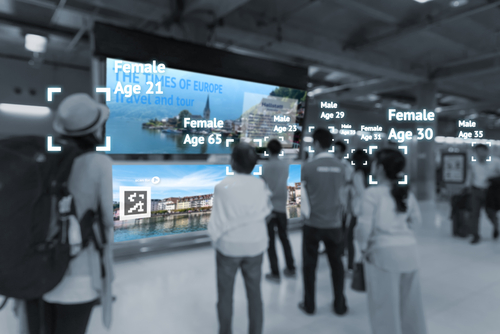DOOH and Biometrics – Taking Personalized Services to the Next Level
By Alex Mardikian
Biometrics technology, once in the realm of science fiction, is a commonplace technology today. Fingerprint, face, and retina scanners are used for granting access to smartphones, bank lockers, homes, etc.
Today, we can use biometric information to identify an individual, check for past behavioral information, and supply relevant messages. The combining of DOOH and biometrics along with the analytics available has given marketers a way to deliver impactful and contextual content that can be served quickly, controlled remotely, and also be measured.
DOOH kiosks, signages, and billboards looking to attract specific demographics can do so using anonymous facial analysis. This information is used to stimulate interaction that yields granular level details about an individual, in terms of gender, likes, income, etc.
Biometrics, when added to digital signage, can deliver information on the traffic that passes by, audience that views, dwell times, and compare results of screen placements. You can set custom criteria that triggers content based on results of biometric identification. You can collect data on the effectiveness of the messaging in real time. The content can be altered according to the data. You can tweak engagement levels based in information relayed based on biometric data, and do so remotely – for example, dynamic pricing and loyalty programs are two types of content that can be displayed based on age and gender information.
For marketers interested in DOOH, such information enables acute targeting of an audience; you can flash the most relevant and appropriate content and market successfully. Retail, entertainment, and transportation are just some of the industries that can benefit from the introduction of biometrics into digital signage.
In a retail environment, age and gender information can trigger messaging. Facial recognition of known shoppers can help present relevant products. Discounted products can be highlighted. Content that informs on products and services meant for an “age group” can be flashed to relevant audiences.
An app or an RFID tag can make the shopping experience even more information-driven for the store and friendlier for the customer. An RFID tag communicating individual preferences can help the wearer save time and money. The data can reveal a lot of information on trends in a given industry, customer preferences, and the content type that leads to the best engagement.
Across any industry, one very useful feature of biometrics is in measuring the effectiveness of ads. This can be achieved by checking for advertised items in a receipt and determining if the purchases were made after viewing the ad.
You can track the movements of a visitor across retail malls and theme parks by using face detection software. This facilitates access to various parts of the space and also informs the management about the path taken by high value customers. You can personalize your branding efforts using biometrics; it could mean projecting a child-friendly image for a certain age group, a senior-sensitive image for another age group.
The tone and wording of the message can be adjusted to best impress the viewer.

